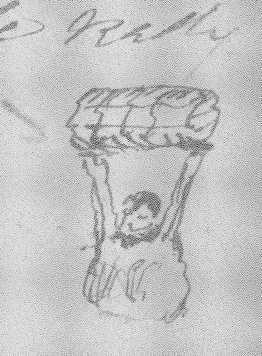By Andrea Cronin
“While we were looking at [150-pound sacks of rice] & I was thinking of getting them off to the ships a procession of fifty athletes filed before us,” wrote Lt. George Henry Preble of the U.S.S. Macedonia in a journal of his voyage to China and Japan on 24 March 1854. “Without being tall, these men were giants of bone and fat & muscle – weighing from 200 to 400 lbs each. As we had seen nothing of the kind before, we received them with exclamations of surprise. They were entirely naked except that they wore a stout silken girdle or sash about six inches broad about their loins concealing what modesty should not expose. At a given signal each of these “strong men” for that is the English translation of their Japanese name, seized two packages of the rice, and holding them above their heads carried them with apparent ease to a place beyond [Commodore Matthew Perry] and deposited them in another pile ready for embarkation.”
Preble’s impression of sumo wrestlers, or Japanese “strong men,” caught my attention as I was reading the George H. Preble diaries in search of material pertaining to the Treaty of Kanagawa, 31 March 1854. In this display of culture and resources just days before the signing of the treaty, the Japanese gifted the Americans with Imperial presents including rice, brocades, silk, lacquered furniture, and a small box of toys. In return, the Americans set up a working example of miniature railroad engine, car, and working telegraph line. In a rather condescending note, Preble thought that the American gift of The Birds of America by John James Audubon was worth more than all the Japanese gave. In the same tone, he recounted a detailed description of a sumo match:
The Japanese invited us to the rear of the [Treaty House] and introduced again their strong men this time as wrestlers. … two of our naked & fat friends disrobed of their gay aprons entered and squatted down in the center of the circle. Then they rubbed themselves under the arms & thighs, with the loose black earth, … they then planted themselves firmly on their feet with their hands on their hips – next locked arms, and struggled. The one striving to push the other outside the circle. It was a simple endurance of breath, and feat of strength – not of skill. There was no attempt at tripping with the feet, or what we call wrestling. … At first the exhibition was interesting but it soon grew tedious from repetition. I was glad to be summoned from it …
George Preble was a difficult man to impress. Many of his assumptions about Japanese culture stem from his assessment that the Japanese at the time were technologically, politically, and socially 300 years behind the progress of the Western world, especially due to the Japanese emphasis on isolationism. While I generally disagree with Preble’s values in his assessment, his description of a sport, which endures in Japan, is enjoyable nonetheless. Today, the rikishi (wrestlers) still wear the keshō-mawashi (apron) and mawashi (loincloth) in the dohyō (circular ring). The match is won by pushing the opponent outside of the circle or forcing the opponent to touch the ground with any part of his or her body other than the feet. George Preble missed the similar culture of discipline and ceremony between the Japanese wrestlers and his sailors in his quick tedium of the event.


